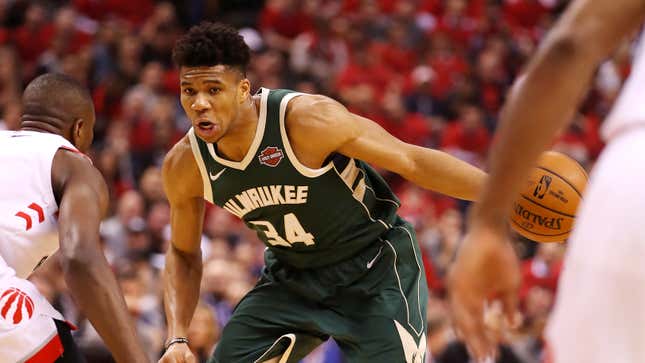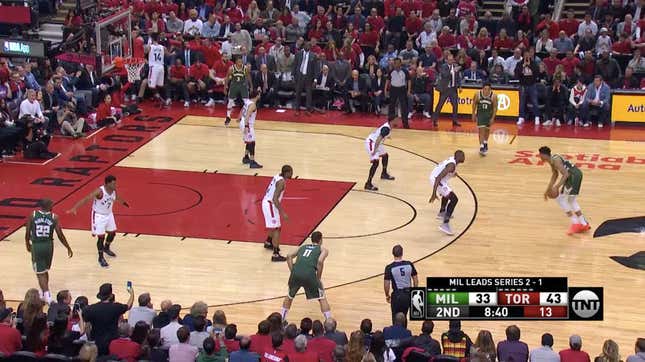
For a top-seeded team that rampaged through the regular season and the first two rounds of the playoffs at a nigh-historic level of dominance, the Milwaukee Bucks feature a dull-ass half-court offense. Often—dismally often—it’s just, well, this:
Over and over and over again: that. The Bucks spread four shooters out along the arc—two on the left, two on the right—and those four shooters kinda chill out while Giannis Antetokounmpo attacks his man off the dribble from the top of the key. By the time he gets to the free-throw line, the play has been resolved: Either he has a route to the front of the rim, or a teammate has been left open for a three-pointer or back-cut, or the offense has stalled and must be reset. It’s a medieval battering ram in sneakers, something a little kid could draw up. It’s an even blunter version of Houston’s offense, only the action everybody knows is coming is a mile-wide Euro-step, rather than a side-step jumper.
In the example above, it didn’t work, so the Bucks just... did it again.
The second try led to an uncontested three for Khris Middleton not because the action actually created anything on its own, but because Kyle Lowry fell asleep in the middle of the lane. Players will do that from time to time, even when the point-of-attack defense holds its ground, as Toronto’s did here. In the most bare-bones sense—Giannis spotted Middleton alone down there in the corner and did not fling the subsequent pass into the rafters; Middleton made the shot—that makes this possession a success for Milwaukee, but not exactly one that can be built upon.
Every team in the NBA, including the decentralized, beautiful-game Golden State Warriors, does this from time to time, clearing out so that its best player can just Go Create A Bucket. What sets the Bucks apart (from everybody but the Rockets, anyway) is that it isn’t something they pull out just in late-game or shortened shot-clock situations, or when they’ve screened their way into a favorable mismatch. It isn’t their last resort, but frequently their first. They’ve got Giannis, and you don’t, and they figure (rightly, for the most part) that if they smash him into your face enough times, eventually your teeth are going to rattle out.
Broadly and self-evidently, this “works,” in the sense that nothing about its creative limitations prevented the Bucks, who do their best work in transition anyway, from mostly steamrolling the league this season, including in their flattenings of the Detroit Pistons and Boston Celtics in the first two rounds of these playoffs. It’s crude and brutish and physically punishing, and its effects are cumulative: Over the course of a game, it gradually wears down even very tough, deep, and disciplined defenses. It’s no surprise the Boston series featured a bunch of lopsided third and fourth quarters.
The fouls pile up, as defenders are forced to maul Giannis to keep him away from the basket. Reserves of energy and focus run dry. Arms and feet get heavy and sluggish. Giannis starts Euro-stepping or spinning his way around tired or foul-troubled bigs with greater ease. Help arrives too early, and the kick-out passes turn into quick drive-kick-drive-kick-drive-kick sequences leading to open threes for Milwaukee’s deep rotation of deadly shooters. Help arrives too late, and Giannis ping-pongs the ball to himself off the backboard three or four times until he can dunk on somebody’s head. Eventually, the Bucks go 60-22 with a plus-8.6 net rating and win their first two playoff series by a total of 138 points. It’s fine.
But of course, on a possession-by-possession basis, it doesn’t always work. The Toronto Raptors have had lots of success over the past two games of the Eastern Conference Finals—both wins for the Raptors—at making it mostly not work. They’re not doing anything especially ingenious, tactics-wise. In basic terms, they’re defending it the way the Celtics tried to: They’re putting a big on Giannis, and instead of waiting for Giannis at the free-throw line—the usual approach to defending a deadly slasher without a dangerous jump-shot—that big is taking a step or two forward, meeting his drive right up near the top of the key. Like so:

From there, the defender—in this case, Serge Ibaka, who pretty much singlehandedly mushed the Bucks in last night’s second quarter—can route Giannis directly into the arms of the help defenders stationed a step away on either side. Even Giannis, the longest of long-striders basically ever, can’t launch a profitable Euro-step from here, and the shortened runway prevents him from getting up to anywhere near full speed. When he tries to drive on Ibaka, he’s mired in Raptors within a single dribble.
This is working better for the Raptors than it did for the Celtics for the same basic reason the Raptors are a better defensive team than the Celtics were: They’ve got a lot of committed, smart, active, long-armed defensive players who are capable of working together for more than a few seconds at a time. But over the past two games, they’ve gotten a huge assist from Milwaukee’s resolute refusal to try anything else. The Bucks just keep pounding Giannis into that wall, again and again and again.
This has led to a fairly grueling two-game stretch for Milwaukee’s MVP candidate: 14-for-33 shooting (42.4 percent) over games three and four of the series; eight makes on 17 free-throw attempts; 12 turnovers against 12 assists. And, of course, they lost both of those games; last night, they got outscored by 19 points in Giannis’s 34 minutes, in a game they lost by 18. Possessions that began with Giannis attacking his man at the top of the key routinely devolved into him swarmed in the middle of the lane, desperately flinging an off-balance pass in the general direction of a teammate in no position to do much good with it.
It may be time to stop using the poor guy as a battering ram, or at least to swing him at a different gate! He showed in the regular season—particularly in a pair of gaudy late-season performances against the long and physical Philadelphia 76ers—that he can smash a defense to rubble from the low post; why not see if he can overpower, say, Danny Green or Kawhi Leonard, or even Ibaka, on the low block? Speaking of those Sixers, in their second-round series against these same Raptors, they made some downhill running room for their own giant, non-shooting point guard (Ben Simmons) by using him as a screener for the ball and letting him attack off the short-roll, Draymond Green-style. If the Raptors are committed to guarding Giannis with a big, why not attack that big from one side of the floor, where it’s harder to put a help defender on both sides of him, and see if Giannis can beat him baseline?
The point is, there ought to be some way to make the job easier for one of the league’s most extraordinarily gifted players. Giannis is the NBA’s most demoralizing man when he’s storming through a set defense from the top of the key all the way to the rim, in part because that’s him making wreckage out of what by all rights ought to be the most favorable setup for stopping him. But he can also beat the next-worst disadvantage, if the Bucks can be arsed to seek it out, instead of pounding him into that wall one more time.